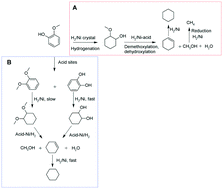当前位置:
X-MOL 学术
›
Catal. Sci. Technol.
›
论文详情
Our official English website, www.x-mol.net, welcomes your
feedback! (Note: you will need to create a separate account there.)
The role of acid and metal sites in hydrodeoxygenation of guaiacol over Ni/Beta catalysts
Catalysis Science & Technology ( IF 4.4 ) Pub Date : 2019/12/12 , DOI: 10.1039/c9cy01970g Penghui Yan 1, 2, 3, 4 , Molly Meng-Jung Li 1, 2, 3, 4 , Eric Kennedy 1, 2, 3, 4 , Adesoji Adesina 5, 6, 7 , Guangyu Zhao 1, 2, 3, 4 , Adi Setiawan 8, 9, 10, 11, 12 , Michael Stockenhuber 1, 2, 3, 4
Catalysis Science & Technology ( IF 4.4 ) Pub Date : 2019/12/12 , DOI: 10.1039/c9cy01970g Penghui Yan 1, 2, 3, 4 , Molly Meng-Jung Li 1, 2, 3, 4 , Eric Kennedy 1, 2, 3, 4 , Adesoji Adesina 5, 6, 7 , Guangyu Zhao 1, 2, 3, 4 , Adi Setiawan 8, 9, 10, 11, 12 , Michael Stockenhuber 1, 2, 3, 4
Affiliation

|
Hydrodeoxygenation (HDO) of guaiacol over Ni metal supported on zeolites (H-Beta and H-ZSM-5) with different Si/Al ratios (12.5, 25, 175) and different metal loadings (2.3–23.4 wt%) was investigated in order to elucidate the role of catalyst acidity and the structure of Ni in the HDO reaction. Results show that the deoxygenation activity and product selectivity depend on the choice of support (acidity, pore size), level of metal loading, and reaction conditions. Guaiacol was deoxygenated in the presence of hydrogen with a maximum cyclohexane yield of 76% at a guaiacol conversion level of 100% over 15.7 wt% Ni/Beta-12.5 catalyst. Compared to Ni/ZSM-5 catalysts, Ni/Beta catalysts with mesopores facilitated the formation of coupling products (1,1′-bicyclohexyl). Under differential reaction conditions, we observed a linear relationship between deoxygenation activity and concentration of acid sites. Over catalysts containing small Ni particles, cyclohexane was formed as a result of a consecutive reduction of guaiacol to catechol and cyclohexane. At higher Ni-loading and consequently larger Ni particles, the selectivity towards cyclohexane increases with increased Ni loading. A higher concentration of nickel hydrides compared to smaller Ni sites was observed by H2-TPD and H2-FTIR over larger Ni species, and the nickel hydrides are believed to be crucial intermediates in the hydrogenation reaction. The 15.7 wt% Ni/Beta (Si/Al = 12.5) exhibits a promising HDO activity due to its good synergistic effect of hydrogenation and deoxygenation functions (high concentration nickel hydrides of and acid sites). In addition, based on the product distribution over catalysts containing mainly small Ni species and the Ni nanoparticles, two different reaction pathways were proposed, and the role of the acid sites and metal sites for each reaction route was discussed.
中文翻译:

Ni / Beta催化剂上酸和金属位点在愈创木酚加氢脱氧中的作用
在不同硅/铝比(12.5、25、175)和不同金属负载量(2.3–23.4 wt%)的沸石(H-Beta和H-ZSM-5)上负载的镍金属上的愈创木酚加氢脱氧(HDO)进行了研究。为了阐明催化剂酸度和Ni的结构在HDO反应中的作用。结果表明,脱氧活性和产物选择性取决于载体的选择(酸度,孔径),金属负载量和反应条件。愈创木酚在氢气存在下脱氧,在15.7 wt%Ni / Beta-12.5催化剂上,愈创木酚转化率为100%时,最大环己烷产率为76%。与Ni / ZSM-5催化剂相比,具有中孔的Ni / Beta催化剂促进了偶联产物(1,1'-bicyclohexyl)的形成。在不同的反应条件下 我们观察到脱氧活性与酸位点浓度之间存在线性关系。在愈创木酚连续还原为邻苯二酚和环己烷的过程中,在含有小Ni颗粒的催化剂上形成了环己烷。在较高的镍载量下,因此镍颗粒较大时,对环己烷的选择性随镍载量的增加而增加。H观察到与较小的Ni位置相比,氢化镍的浓度更高2 -TPD和H 2 -FTIR在较大的Ni物种上,并且氢化镍被认为是氢化反应中的关键中间体。15.7 wt%的Ni / Beta(Si / Al = 12.5)由于具有良好的加氢和脱氧功能(高浓度的NH 3和H 2的氢化镍)的协同作用,因此显示出令人振奋的HDO活性。此外,基于产物在主要含有少量Ni物种和Ni纳米颗粒的催化剂上的分布,提出了两种不同的反应途径,并讨论了酸位和金属位在每种反应路线中的作用。
更新日期:2020-02-13
中文翻译:

Ni / Beta催化剂上酸和金属位点在愈创木酚加氢脱氧中的作用
在不同硅/铝比(12.5、25、175)和不同金属负载量(2.3–23.4 wt%)的沸石(H-Beta和H-ZSM-5)上负载的镍金属上的愈创木酚加氢脱氧(HDO)进行了研究。为了阐明催化剂酸度和Ni的结构在HDO反应中的作用。结果表明,脱氧活性和产物选择性取决于载体的选择(酸度,孔径),金属负载量和反应条件。愈创木酚在氢气存在下脱氧,在15.7 wt%Ni / Beta-12.5催化剂上,愈创木酚转化率为100%时,最大环己烷产率为76%。与Ni / ZSM-5催化剂相比,具有中孔的Ni / Beta催化剂促进了偶联产物(1,1'-bicyclohexyl)的形成。在不同的反应条件下 我们观察到脱氧活性与酸位点浓度之间存在线性关系。在愈创木酚连续还原为邻苯二酚和环己烷的过程中,在含有小Ni颗粒的催化剂上形成了环己烷。在较高的镍载量下,因此镍颗粒较大时,对环己烷的选择性随镍载量的增加而增加。H观察到与较小的Ni位置相比,氢化镍的浓度更高2 -TPD和H 2 -FTIR在较大的Ni物种上,并且氢化镍被认为是氢化反应中的关键中间体。15.7 wt%的Ni / Beta(Si / Al = 12.5)由于具有良好的加氢和脱氧功能(高浓度的NH 3和H 2的氢化镍)的协同作用,因此显示出令人振奋的HDO活性。此外,基于产物在主要含有少量Ni物种和Ni纳米颗粒的催化剂上的分布,提出了两种不同的反应途径,并讨论了酸位和金属位在每种反应路线中的作用。











































 京公网安备 11010802027423号
京公网安备 11010802027423号